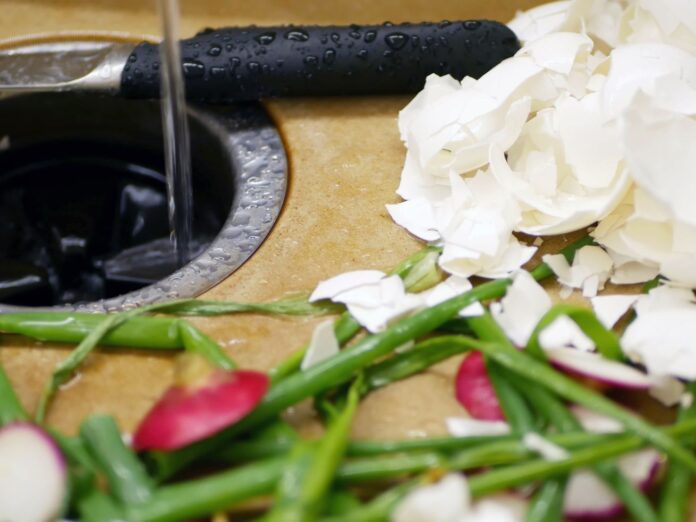[ad_1]

Don’t let improper use and deferred maintenance prevent your garbage disposal from working optimally. Follow these expert tips to learn how to maintain this pulverizing powerhouse, so it stays clean and performs to its potential.
Unseen and under-appreciated, the garbage disposal likely works harder than any other kitchen appliance. But it requires some care to function at its best. Learn how your disposal works, the do’s and don’ts of its operation, including what to put in it and what not to, and how to keep it clean and running smoothly for peak performance that lasts.
How a Garbage Disposal Works
Because few homeowners see past the rubber splash guard at the bottom of their sink, most don’t think about how a garbage disposal works.
Beneath the splash guard, you’ll find the upper chamber where the food scraps accumulate. Inside this chamber are the shredding ring, flywheel, and impellers. These pieces grind up the waste, enabling it to pass into the lower chamber. Here, the smaller food particles mix with water before moving into the P-trap and down the drainpipe. Other parts of a disposal include a 1/3 to 1-horsepower motor, plumbing attachments, and a reset button.
Most homeowners opt for a standard ⅓ horsepower disposal because they’re affordable. These smaller units have only one grinding wheel so they can’t tolerate all foods. Larger, more powerful units include up to three grinding wheels which will pulverize just about anything you throw at them. Always check the manufacturer’s directions before using any disposal to understand how it works and what it can handle.
Tips for a Smooth-Running Garbage Disposal
Since the inner workings of a garbage disposal are, for the most part, out of sight, out of mind, here are some pro tips to keep yours running in top form:
The Dos
- Do run your garbage disposal regularly. Food and debris allowed to accumulate in the upper chamber for days will begin to decompose and smell.
- Do keep the cold water flowing when you run the disposal. The water moves the small particles through the P-trap and prevents a clogged drain.
- Do use cold water. Hot water turns some foods like fats and starches soft and slippery, making them harder to grind, which leads to clogs. It also moves fats further down the pipe where they’ll cool, stick to the sides of the pipe, and form a clog.
- Do break up large scraps before grinding. This practice prevents overworking the motor.
- Do grind ice cubes once a month. The ice helps keep the blades sharp and removes food particles stuck to the inside of the upper chamber.
- Do clean your garbage disposal regularly.
- Do hand-crank the unit to loosen a jam. By inserting a hex key into a slot located at the bottom of the disposal, you can turn the blades and free them up.
The Don’ts
- Don’t grind non-food or hard-to-break-down food items. The unit wasn’t designed to dispose of plastic scrubbers, paper towel scraps, broken glass, hard fruit pits, or nutshells.
- Don’t use drain openers. The chemicals can damage your disposal and potentially splash in your face. If you have a clogged drain, call a professional.
- Don’t put your hand in the unit. Always disconnect from the power before addressing any malfunction and use tools to access the grinding chamber.
- Don’t forget the reset button, designed to trip when the motor overheats. If the unit doesn’t turn on, press the reset button and try again.
- Don’t grind the following foods with a low-horsepower, single-blade unit:
Fibrous foods: Their strings will wind around the blades, causing the motor to seize. And even if they get processed through the disposal, they’re liable to clog your pipes. Examples include celery, corn husks, asparagus, artichokes, edamame pods, banana peels, and rhubarb. The same goes for long peelings of apples, carrots, potatoes, and the like.
Pits, bones, and meat: With only one grinding blade, and minimal power, these items tend to bounce around inside smaller units without grinding. Over time, they may get through but will lead to a clog.
Grease and fat: No matter which size unit you have, avoid fatty sauces, gravy, butter, and cheese, which are apt to congeal. Oily food waste should not be disposed of in the drain, with or without a disposal.
How to Clean a Garbage Disposal
Follow these steps every month to keep your garbage disposal running smoothly and smelling fresh.
- Use a flashlight to look inside for any leftover food debris. If there’s anything in there, turn off the power and remove it. Then, restore power before proceeding.
- Drop a handful of ice cubes down the disposal with about ½-cup of coarse salt. With the water flowing, run the unit for about a minute to dislodge any food buildup stuck to the chamber walls.
- Next, pour about a cup of white vinegar down the drain and follow it with a handful of baking soda.
- While that combination is fizzing, use an old toothbrush to scrub the rubber flanges of the splash guard. If it’s removable, take it out and scrub the underside as well.
- Finally, give the unit one final flush. To do this, insert the stopper and fill the sink about ¾-full with warm water and a tablespoon of dish soap, giving it a good swish to mix. Then, pull the plug and let the water drain with the unit running.
In between cleanings, grinding a few slices of fresh lemon or peppermint leaves will keep your unit smelling fresh.
Your garbage disposal doesn’t have to be a mysterious contraption under the sink. With a bit of time and know-how, you can keep it running cleanly and smoothly every day.
[ad_2]
www.thisoldhouse.com










